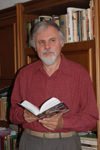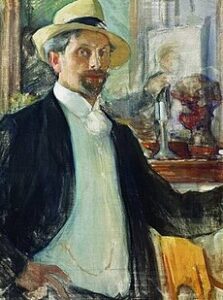By Alex Gordon


HAIFA, Israel — Leonid Pasternak, a painter and professor at the Moscow College of Painting, Sculpture and Architecture, a master of portraiture and book illustrations, went down in history in the shadow of his son Boris, a poet and Nobel Prize winner in literature, whom he loved and with whom he diverged in his attitude toward common ancestry.
Leonid Pasternak was born on March 22, 1862, in Odessa. As a student, he failed to enter the Moscow College of Painting, Sculpture and Architecture because of his Jewish origin, and he went to Munich, where he graduated from the Academy of Arts. After selling to the owner of the Moscow Art Gallery Pavel Tretyakov the painting “Letter from the Motherland” in 1889 Pasternak, then an unknown artist, married the pianist Rosalia Kaufman, a graduate of the Vienna Academy of Music, who concertized throughout Europe and later became a teacher at the Odessa Academy of Music. In the same year, the couple settled in Moscow, where Pasternak opened a drawing school. February 10, 1890, the couple had their first son Boris.
In 1894 Pasternak was offered a position as a professor at the Moscow College of Painting, Sculpture and Architecture on condition that he accept Orthodoxy. Pasternak refused. In a letter to the school’s inspector, Prince Lvov, he stated, “I grew up in a Jewish family and will never go to the point of leaving Jewishness for a career or generally to improve my social position.” Subsequently he did become a professor at the college and was in that position for a quarter of a century. In 1905 Pasternak became a member of the St. Petersburg Academy of Painting. He was a regular illustrator of Lev Tolstoy’s novels and the author of many portraits of the writer.
In September 1921, Leonid and Rozalia Pasternak and their daughter Lydia left Russia and moved to Germany. In Berlin, Pasternak became friends with the Jewish poet Chaim Nachman Bialik. Pasternak did not return to the place where he once had a homeland that did not want him back, and where his spiritually distant son waited for him and did not. His last words were “peace and harmony,” and he often liked to say them, but there was much disharmony in his world. 1
Bialik recalled Pasternak’s fascination with Rembrandt: “He came as a teacher, teaching us art, and as an artist-creator. And he did not come empty-handed but brought an album of portraits of Jewish writers and a notebook with the manuscript of the article “Rembrandt and Jewry in his work” in Berlin in 1933. Pasternak was fascinated by the work of the Dutch artist, for he discovered the connection between the work of Rembrandt and Jewry:
“What brought him (Rembrandt) close to the Jews was the tragedy of his personal life, which was echoed in the historical tragedy of the latter, hardened by eternal exile, […] eternal objects of persecution, torture, social untruths and cruel blows of fate.” Analyzing Rembrandt’s famous painting “Saul and David,” Pasternak believed that he saw in the painting not King Saul, but a simple Amsterdam Jew, perhaps a servant of a neighboring synagogue, and on his face – the long-suffering life of the Jewish people. Looking at the Amsterdam Jews in Rembrandt’s paintings, Pasternak looked into the depths of Jewish history: “In these exotic Dutch Jews lived still the breath of biblical tradition, […] there was still much that gave off the East and the echoes of their distant homeland.”
Pasternak realized the connection with his ancestors, the images of Rembrandt, after meetings with Bialik.The poet and the artist met at a dacha near Odessa in 1911. It was then that Pasternak first painted a portrait of Bialik. Each of their meetings was for him “something like reading the living Bialik.” The artist recalled the years of World War I, when Bialik came to visit him in Moscow. He came to the Pasternaks to talk about painting, which he loved very much.
Bialik drew attention to the lack of art albums of Jewish artists, dreamed of promoting the art of painting among Jews. The poet and the artist spent whole hours in friendly conversation and in defining plans for joint work in the field of fine art and fiction. Their collaboration continued in Berlin.
Bialik moved to Germany at the request of the writer Maxim Gorky and with Lenin’s permission. During the German period of his life (1921-1924) Bialik and his wife lived in the town of Homburg near Berlin. At the time of the publication of Rembrandt, Bialik, who was 50 years old in 1923, was busy publishing a jubilee collection of his works. He was engaged in publishing activities, for which he attracted Pasternak: “I am infinitely glad to see Pasternak as an employee of the publishing house, for I am the one who brought his heart closer to Jewish work and attracted him to our camp.”
The artist so characterizes the influence of Bialik on him: “I grew up in a Russian environment, received a Russian upbringing, developed under the influence of the tendencies of assimilation and in the duty of service to the Russian people. And – the strange fate of the Jews of our generation – now we get a lot of blame from Bialik for the fact that we did not give ourselves entirely to our disadvantaged people – and on the other hand – I have often heard reproaches that as a Jew I cannot be a purely Russian artist. […] We looked into each other’s eyes, and, I don’t know, I don’t understand why, maybe it was the racial commonality that breathed on us from the depths of the ages, or maybe we suddenly felt that we belonged to the same world, the world of art, – but that look was enough. From that moment our souls were twinned. […] I was far from the inner Jewish life. […] When I look at him, it seems that the essence of the people’s soul, its daring and aspirations have condensed in the poet, and it boils in Bialik’s soul.”
Leonid was in solidarity with his people. He found like-mindedness in Rembrandt, but not in his son. In May 1933 Leonid Pasternak’s book about Tolstoy with autobiographical notes (1932) was burned by the Nazis. The exhibition that the artist was preparing for his 75th birthday in Berlin in 1937 was banned. As a result of Kristallnacht, Pasternak relived the horror of the 1871 anti-Jewish pogrom in Odessa. In 1938, the Pasternaks immigrated to England to join their daughter Lydia. The artist died in Oxford on May 31, 1945.
In a letter to a cousin dated October 13, 1946, Boris Pasternak said that he had begun writing a novel in which “I settle […] scores with Jewry (which means he has decided to finally break away from the Jewish people), with all shades of nationalism (the novel “Doctor Zhivago”). Six months after Leonid Pasternak’s death, his son began writing a novel in which he was going to “settle scores” with his father’s people.
*
Alex Gordon is professor emeritus of physics at the University of Haifa and at Oranim, the academic college of education, and the author of 10 books.